Improving locomotive starting performance
A comprehensive review on the application of supercapacitor starting assist technology on locomotive starting performance.
Download the PDF version of the Improving Locomotive Starting Performance white paper.
INTRODUCTION
The rail industry continually explores and implements technology enhancements that improve locomotive efficiency, reduce operating costs and increase environmental sustainability. These enhancements and new legislative requirements create additional parasitic loads from expanded onboard technology usage, more frequent locomotive engine starting resulting in higher battery stress.
Common AESS systems need several operating parameters to be satisfied before auto-shutdown is initiated. One of these parameters is sufficient battery state-of-charge. The combined result is fuel consumption where the locomotive engine idles to charge the battery while also reducing the achievable lifetime of batteries and causing increased locomotive dead-won't-start (DWS) events. In fact, a locomotive will experience a DWS failure once every three years, affecting availability and reliability metrics.
This paper offers a thorough technical and financial assessment of applying supercapacitor starting assist technologies to avoid dead-won’t-start events while also reducing unscheduled locomotive battery and starting system maintenance.
The analysis reviews data collected from the ZTR KickStart™ supercapacitor technology that has been installed on thousands of locomotives globally and highlights opportunities to:
- Improve locomotive availability
- Reduce fuel consumption
- Reduce locomotive emissions
Improving Locomotive Availability
Eliminating Dead-Won’t-Start (DWS) Situations Caused by Battery Voltage Drops
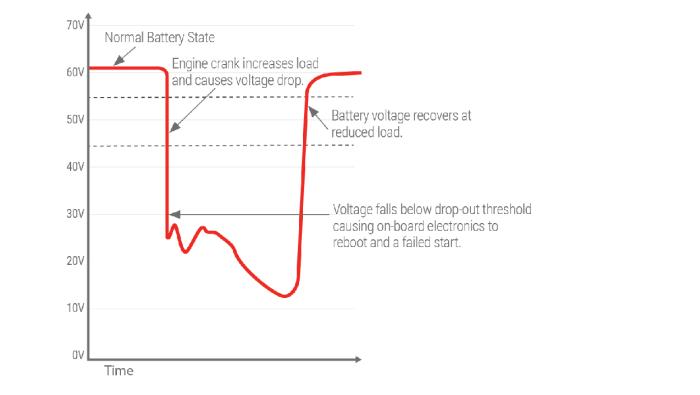
Engine Restart Without Supercapacitor Starting Assist
Batteries are one of the leading causes for engine starting problems. Brownouts are caused when high current draw on a weakened battery causes the battery voltage during engine cranking to drop below the minimum voltage requirement needed to maintain the onboard electrics. Once the voltage drops below the dropout voltage, the onboard electronics will cycle and the cranking will cease causing a dead-won't-start.
Figure 1. Engine Restart Without Supercapacitor Starting Assist: Showing a failed start due to the engine crank causing voltage to drop below 55 volt threshold.
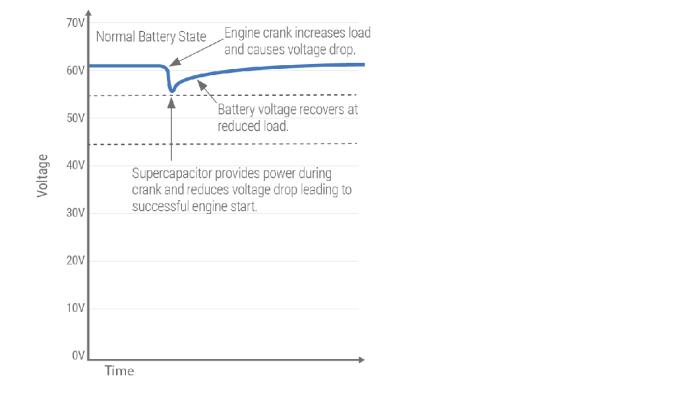
Engine Restart With Supercapacitor Starting Assist
With the implementation of supercapacitor starting assist technology, there is a high power output from the supercapacitor for the engine cranking to cut the current draw on the battery and avoid a voltage drop to the onboard electrics. Even with a weakened battery, the locomotive control system voltage is maintained above the minimum voltage to avoid a brown out and results in a successful restart. The supercapacitor is then recharged in minutes after the locomotive starts.
Figure 2. Engine Restart With Supercapacitor Starting Assist: Showing a successful engine start using a supercapacitor starting assist.
On average, a locomotive will have a dead-won’t-start caused by weakened batteries once every 3 years. This is avoidable with the implementation of supercapacitor starting assist technologies.
The cost of a DWS ranges from about $4,000 to more costly mainline failures that can have financial implications up to $45,000 per instance. Avoiding one DWS every 3 years per locomotive across a fleet of 1,000 locomotives at an average cost of $21,000 per DWS would save a railway over $7,000,000 each year.
How Supercapacitors Work
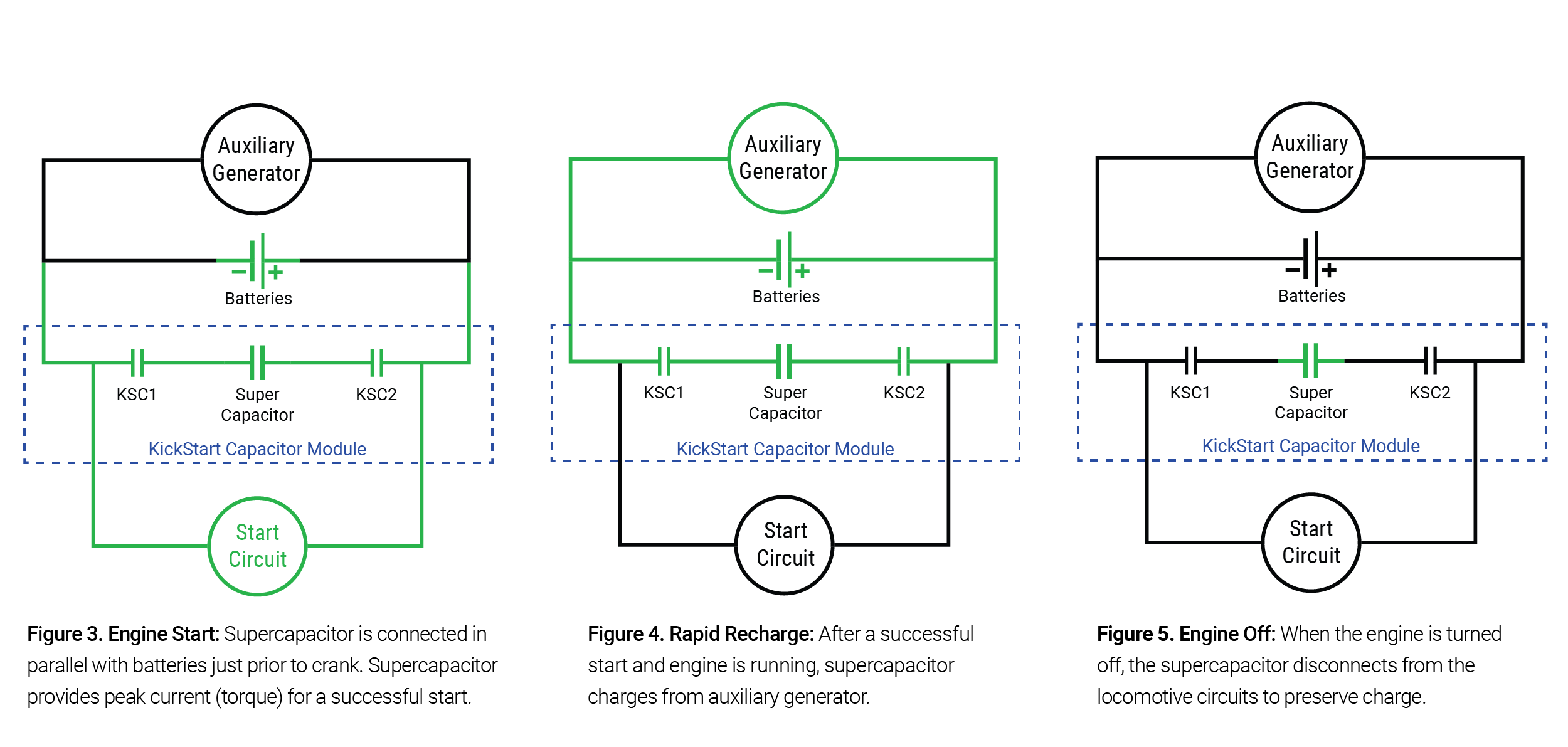
Reducing Battery replacement frequency by avoiding battery stress.
Locomotive lead-acid batteries can prematurely fail due to internal corrosion, sulfation and loss of electrolyte. These battery failure mechanisms are accelerated by deeper and more frequent discharges as well as higher battery temperatures.
With the implementation of supercapacitors starting assist, the useful life of batteries are extended. As an example, consider a battery in poor state of health that is unable to provide the power and peak current required to turn the engine. A supercapacitor starting assist system can provide critical power during the peak current draw on the battery during the crank thus reducing the deep cycles that cause battery heating and degredation. This extends the life of the batteries and lowers maintenance costs over the life of the battery.
The typical battery life of a lead acid battery in a locomotive application with an AESS is expected to be about 2 years. This life can be doubled to an expected 4-5 years by installing a supercapacitor starting assist system. At a typical battery replacement costs of $6,000 per locomotive, the supercapacitor system can save about $6,000 to $12,000 in battery replacements over 5 years.
Reduce Starting System Maintenance with Reduced Battery Voltage Restarts
Case Study: KickStart™ supercapacitor starting assist technology has demonstrated the ability to reduce battery voltage restarts by 85% thus cutting the amount of cycling on batteries and reducing the wear on locomotive starting systems.
Case Study: KickStart™ supercapacitor starting assist technology has demonstrated the ability to reduce crank time on restarts by 25% thus cutting the current drawn from a battery while also minimizing wear on starting systems.
Reducing Locomotive Fuel Consumption
Fuel consumption is a critical driver of locomotive operating expenses. It’s the second largest expense for a railway with consumption rates between 4-5 gallons per hour while idling up to nearly 200 gallons per hour for larger locomotive engine sizes at higher notch settings. At a rough diesel price of $4 per gallon, it can cost a locomotive over $800 in fuel per hour of operation. Across a fleet of hundreds or thousands of locomotives this could mean billions of dollars in fuel used annually which means making even small improvements in efficiency can have a significant impact on the overall profitability of a railway. This has driven many railways to set strategic plans that include fuel reduction targets of more than 30% over the next 15 years.
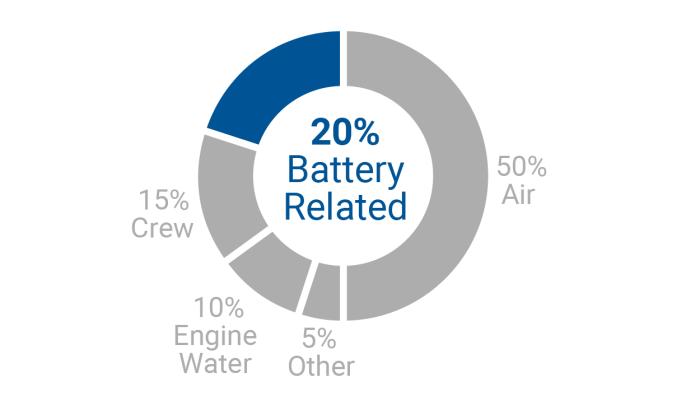
Decreasing Idle Time
Supercapacitor starting assist technologies like KickStart have become a complimentary technology to automatic-engine-start-stop (AESS) systems to reduce engine idle time. An AESS system like SmartStart® IIe can provide anywhere from 5,000 gallons to more than 8,000 gallons per year in fuel savings depending on the locomotive model, utilization, and in service days by reducing engine idle time.
Figure 6. Causes of Locomotive Idle Time: 20% of locomotive engine idling is caused by battery related issues. 50% of those battery related issues are due to weakened batteries.
The AESS will automatically shutdown the locomotive under predetermined conditions to cut idle time and conserve fuel. As battery levels drop or availability is needed, the AESS restarts the locomotive engine automatically to provide power or charge the locomotive batteries.
Case Example of Overall Fuel Reductions: KickStart supercapacitor starting assist technology has been documented to provide a 10% reduction in overall idle time by cutting idle time needed for battery charging. This reduced fuel consumption by over 1,080 gallons per year per locomotive. This equates to roughly $4,320 per locomotive per year.
Reducing Locomotive Emissions
Corporate social responsibility goals, shareholder requirements and legislative requirements are creating decarbonization targets for railways that aim for 30%-40% reductions in emissions by 2035-2040.
Averaging 10,180 grams of CO2 for every gallon of fuel consumed, supercapacitor starting technologies can save 10.9 tonnes of CO2 per year per locomotive that they are installed on. A fleet of 1,000 locomotives equipped with supercapacitor starting assist technology could cut 10,990 Tonnes of CO2 each year which is equivalent to removing 2,219 cars from the road or planting 11,889 acres of forest.
While comparisons are made in Tonnes of CO2 equivalence, these emissions reductions actually represent tangible reductions in air quality contaminants such as 7,181 grams of Particulate Matter (PM), 150,509 grams of Nitrogen Oxide byproducts (NOx) and 28,754 grams of Carbon Monoxide (CO) which can cause adverse health impacts. It is important to note contaminants vary on the locomotive type, age and condition.
ROI for Implementing Locomotive Supercapacitor Starting Assist technologies
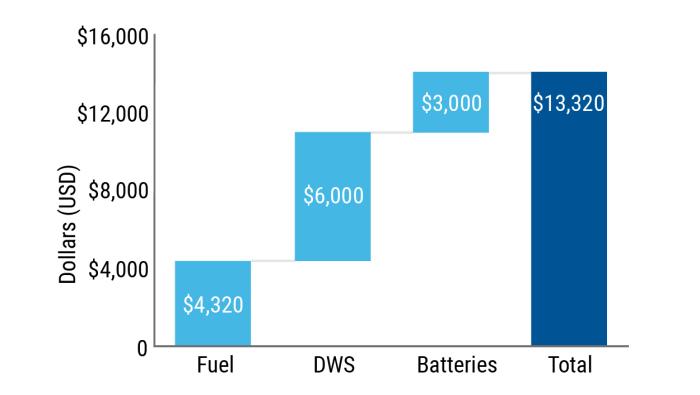
Annual Savings
The total average annual savings associated per locomotive equipped with a supercapacitor starting assist solution like KickStart™ is about $13,320/year comprised of:
$4,230/year for fuel reduction,
$6,000/year in avoided costs for preventing dead-won’t-starts
$3,000/year in costs avoided by extending battery life
Figure 8. Annual Savings Per Locomotive With a Supercapacitive Starting Technology: Graph showing annual savings per locomotive due to fuel reductions, dead-won't-start avoidance, and increased battery life.
Implementation Costs
The costs of purchasing and installing a supercapacitor starting assist technology like KickStart is quite low in comparison to the overall value generated from the systems and is expected to be below $15,000 for purchase price and installation costs per system.
Supercapacitors systems like KickStart are maintenance free and can withstand hundreds of thousands of charge and discharge cycles, making them much more durable than traditional batteries and without any ongoing maintenance costs.
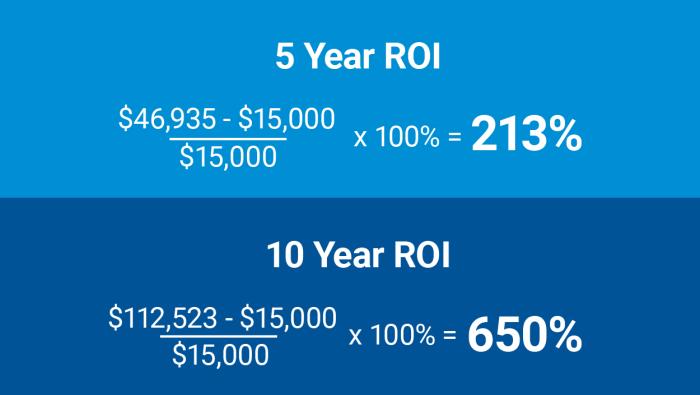
Return on Investment
Implementing supercapacitor starting assist technology for locomotives like KickStart™ is expected to generate more than $112,000 in savings over 10 years when the supercapacitor asset life is 20 years. Considering the low $15,000 investment, the payback period is less than 1.5 years.
A graph showing the 10 year cash outflows and savings is below, where a 10 year cumulative savings of $112,000 is achieved, assuming reductions in battery replacements from once every 2 years to once every 4 years.
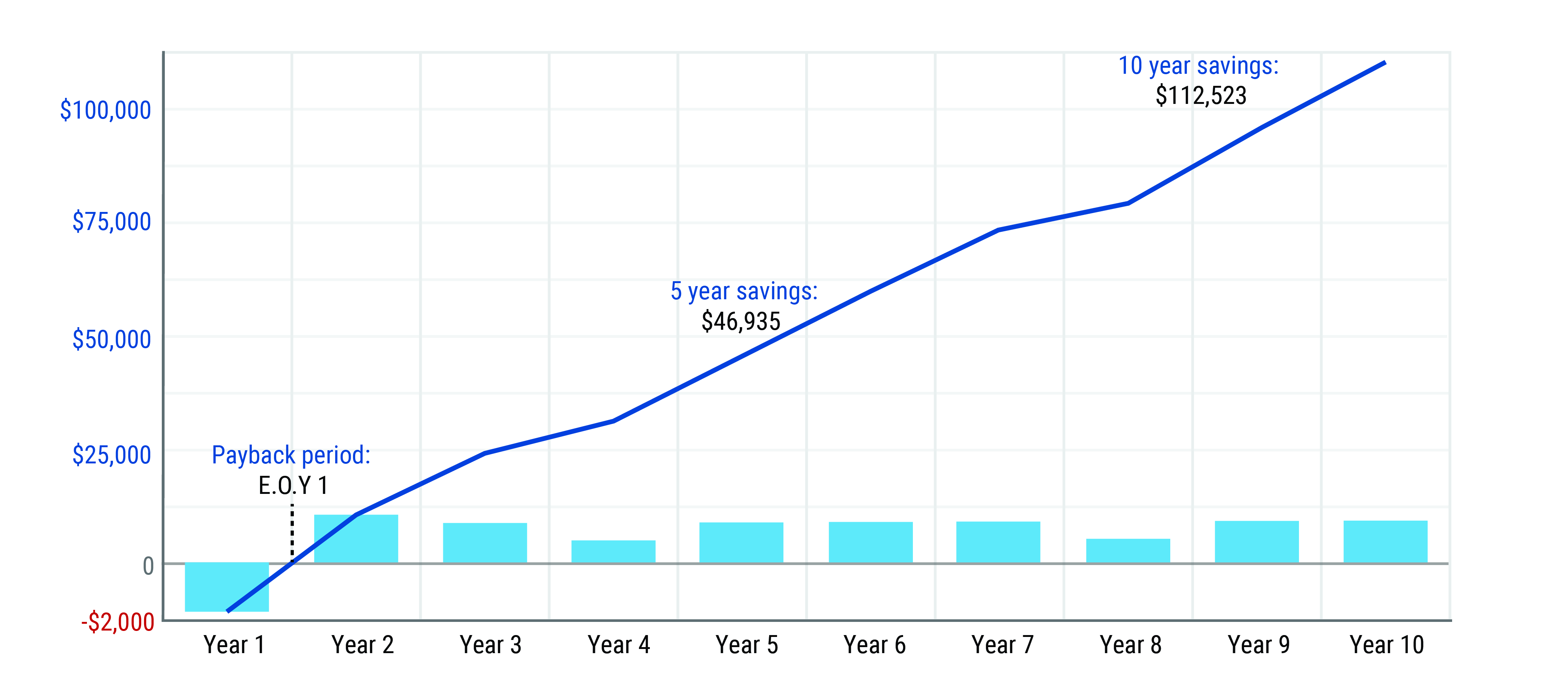
Figure 9. Cumulative Net Savings: Graph showing cumulative net savings per locomotive after installing supercapacitor starting assist technology.
Conclusion
In conclusion, the application of supercapacitor starting assist technology on locomotives can provide significant benefits to the rail industry. This comprehensive review has shown that installing a system like the ZTR KickStart supercapacitor technology can help reduce fuel consumption, lower emissions, and improve locomotive availability.
With fuel consumption being a significant driver of locomotive performance, any reduction can substantially impact profitability. Supercapacitor technology also plays a crucial role in reducing locomotive emissions, essential to meeting decarbonization targets.